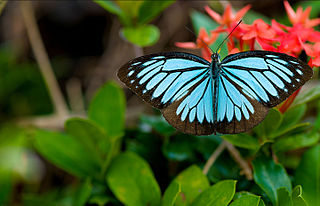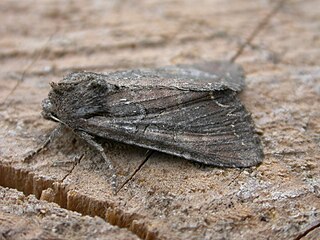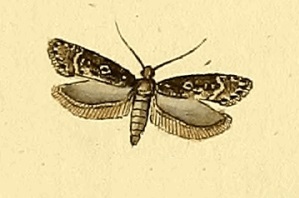
The shoulder-striped wainscot is a moth of the family Noctuidae. The species was first described by Carl Linnaeus in 1761. Some authors place it in the genus Mythimna. It is found throughout Europe and in Russia to the west of the Urals.

Apamea crenata, known as the clouded-bordered brindle, is a moth in the family Noctuidae. It is distributed throughout the Palearctic realm. In the North it crosses the Arctic Circle, in the Mediterranean it is found only in cool locations and mountains avoiding very hot areas. In the Alps, it rises to an altitude of about 2000 metres.

Pareronia valeria, the common wanderer or Malayan wanderer, is a medium-sized butterfly of the family Pieridae, that is, the yellows and whites, and is found in India and Southeast Asia. The butterfly found in India is sometimes considered as a separate species, Pareronia hippia.

Jamides bochus, the dark cerulean, is a small butterfly found in Indomalayan realm that belongs to the lycaenids or blues family. The species was first described by Caspar Stoll in 1782.

Hypolimnas misippus, the Danaid eggfly, mimic, or diadem, is a widespread species of nymphalid butterfly. It is well known for polymorphism and mimicry. Males are blackish with distinctive white spots that are fringed in blue. Females are in multiple forms that include male-like forms while others closely resemble the toxic butterflies Danaus chrysippus and Danaus plexippus.

Lacanobia suasa, the dog’s tooth, is a moth of the family Noctuidae. It is found in the Palearctic realm.

Mesapamea secalis, the common rustic, is a moth of the family Noctuidae. The species was first described by Carl Linnaeus in his 1758 10th edition of Systema Naturae. It is found in Europe, north-west Africa, Turkey and northern Iran.

Grammodes stolida, the geometrician, is a moth of the family Erebidae. The species was first described by Johan Christian Fabricius in 1775. It is found in Africa, southern Europe, most of Asia and Australia. It migrates to central and northern Europe as far north as England, Denmark and Finland.
Helcystogramma heterostigma is a moth in the family Gelechiidae. It was described by Alexey Diakonoff in 1967. It is known from the Philippines (Luzon).

Metzneria metzneriella is a moth of the family Gelechiidae. It is widely distributed throughout Europe, as well as Turkey and southern Siberia. The habitat consists of dry pastures and calcareous soils.
Ptocheuusa paupella, the light fleabane neb, is a moth of the family Gelechiidae. It is found from central and southern Europe to the Ural Mountains. It is also found in Turkey and India.

Gelechia sororculella, the dark-striped groundling, is a moth of the family Gelechiidae. It is widely distributed from Europe, throughout Siberia to the Russian Far East.

Scrobipalpa samadensis, the buck's-horn groundling, is a moth of the family Gelechiidae. It is found in most of Europe and Russia.
Ardozyga compsochroa is a species of moth in the family Gelechiidae. It was described by Edward Meyrick in 1904. It is found in Australia, where it has been recorded from South Australia and New South Wales.
Ardozyga penthicodes is a species of moth in the family Gelechiidae. It was described by Edward Meyrick in 1921. It is found in Australia, where it has been recorded from southern Queensland.
Idiophantis chiridota is a moth of the family Gelechiidae. It was described by Edward Meyrick in 1914. It is found in Sri Lanka, Thailand, on the Sunda Islands and Fiji.
Megacraspedus exilis is a moth of the family Gelechiidae. It was described by Walsingham in 1909. It is found in Mexico (Guerrero) and the southern United States, where it has been recorded from Texas.
Aeolanthes diacritica is a moth of the family Depressariidae. It is found in India (Assam).
Odites fruticosa is a moth in the family Depressariidae. It was described by Edward Meyrick in 1915. It is found in India.
Hypercallia alexandra is a moth in the family Depressariidae. It was described by Edward Meyrick in 1909. It is found in Peru.










